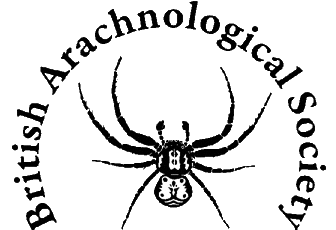Introduction
Arachnology is the study of arachnids. Although mites and ticks are arachnids, for a number of reasons they have their own science, called Acarology, devoted to them.
What are Arachnids?
Back in ancient Greece a maiden had the audacity to challenge the Goddess of Wisdom to a spinning contest. As a punishment she was for ever afterwards forced to spin and weave. Her name, ἀράχνη (Arachne) gave rise to the word used to study spiders and their relatives: Arachn[e] ology (science/study of).
Arachnids are an ancient group of creatures dating back to the Silurian period, more than 420 million years ago (earlier ones have allegedly been found but there status as Arachnids is arguable). They belong to the Arthropods ('jointed limbs') that account for over 80% of all living animals and include the insects, crustaceans, millipedes, and centipedes. Arthropods are characterised by their tough segmented outer shell, or exoskeleton, and jointed limbs.
Arachnids have four pairs of legs, a pair of jaws (the chelicerae) and a second pair of appendages (the pedipalps). They do not have antennae or wings. Included in this diverse group are:
- spiders
- scorpions
- false-scorpions
- harvestmen or 'daddy-long-legs'
- whip scorpions
- palpigrades
- whip spiders
- ricinuleids
- sun and wind spiders
- mites
Arachnids have a body usually divided into two parts, the prosoma (cephalothorax or prosoma) and opisthosoma ('abdomen'), This contrasts with insects which have their body divided into three parts: head, thorax and abdomen. Mites and harvestmen bodies are less obviously divided, having the prosoma and opisthosoma fused together. The prosoma carries six pairs of appendages: the four pairs of legs, pedipalps and chelicerae. Pedipalps and chelicerae are modified in the different arachnid groups and may form spiny grasping limbs or lobster-like claws. The prosoma may also carry varying numbers of eyes.
Virtually all arachnids are terrestrial. However, some spiders, mites and palpigrades occur in both fresh water and intertidally on the seashore in shallow salt water. Halacarid mites are known from 4000m depth seawater.
Breathing is through the use of tracheae (breathing tubes like those found in insects) lung-books or, as in spiders, both.
The vast majority of arachnids are carnivorous, active predators. Some are scavengers and others parasites. The mites include groups that are herbivores, carnivores, parasites (on both plants and animals) and detritivores (feeding on dead plants and animals). Scorpions and false scorpions have pedipalps which have pincers at their ends which are used, amongst other things, to catch, hold and even kill prey. In most arachnids digestion occurs outside the body, digestive juices being poured into or over their food that is chewed and held by the jaw-like chelicerae.
If you are a predator, reproduction is often a risky business as partners can be potential meals. Arachnids have developed 'indirect sperm transfer' as a way of minimising the risk of being eaten. With this form of mating, there is no intimate coupling so males have a better chance of survival. Some males avoid the risk altogether by depositing packets of sperm (spermatophores) for the female to pick up, either in her presence or randomly. To 'neutralise' the aggressive nature of females, males have adopted many techniques. They may grasp the pedipalps of the female so she cannot attack, offer her an insect to eat while he mates, tie her down, seduce her with vibrations, or enact a complex dance to signal who he is and what he intends. Eggs may be laid or carried around by the female or, as in scorpions, the young may be born live. The young may grow up independently or be cared for by their mother until old enough to fend for themselves. Some mothers even feed a milky secretion to their young.
The use of silk and silk-related compounds is widespread in the group, particularly in the spiders. It is used in mating, nesting, hiding, hunting, trapping and even ballooning (q.v.).
